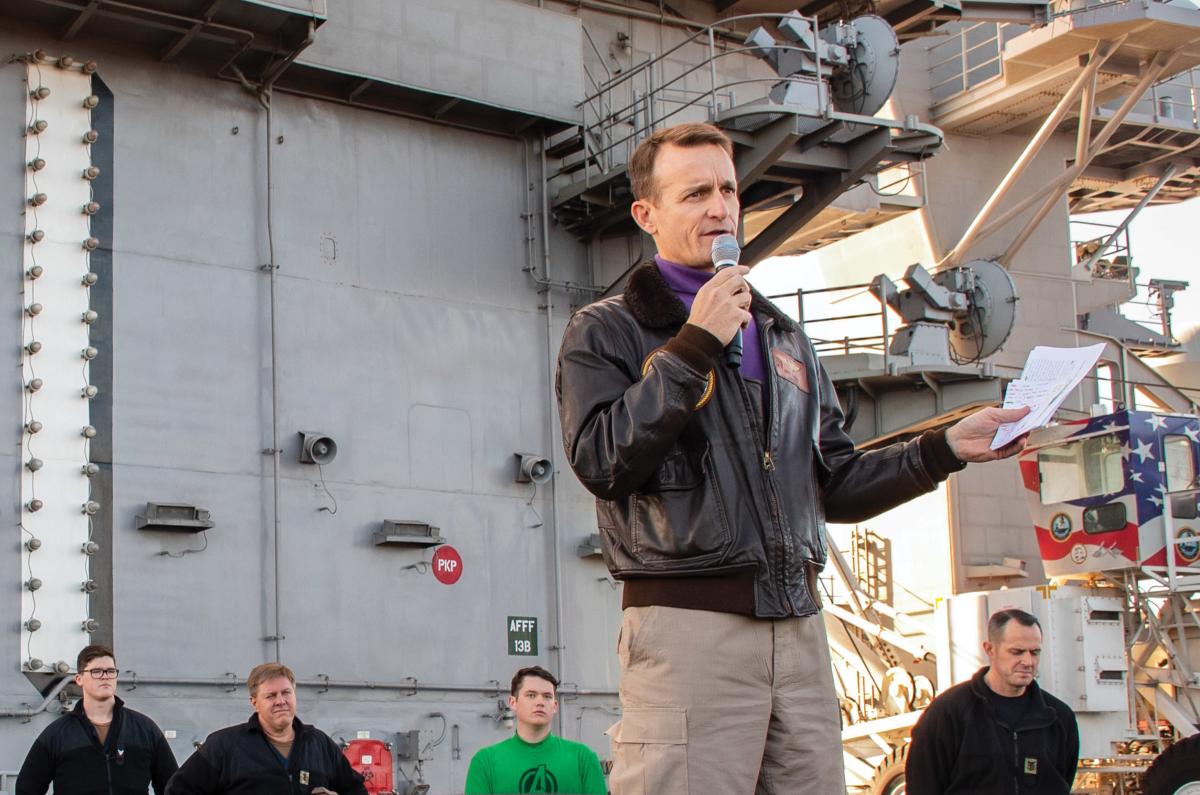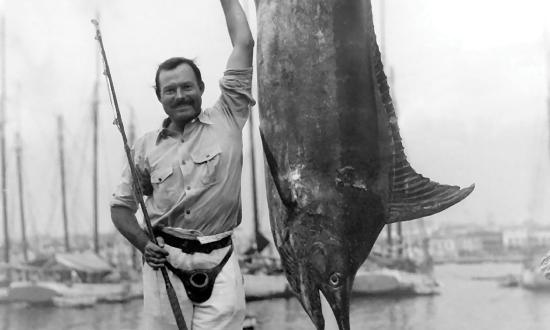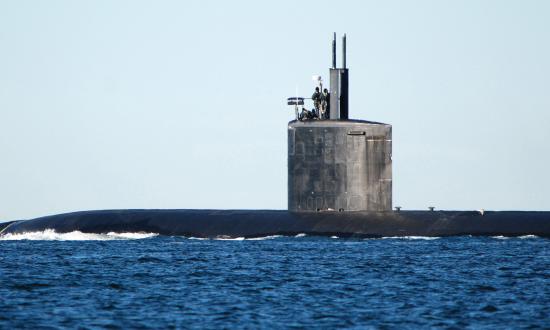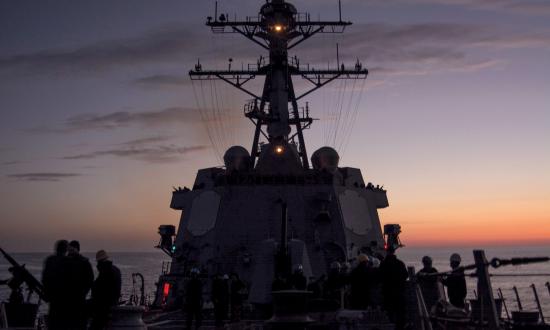"We are not at war. Sailors do not need to die,” wrote Captain Brett Crozier, commanding officer of the USS Theodore Roosevelt (CVN-71). This concluded the letter he sent up his chain of command as a “red flare” in late March 2020. Captain Crozier was battling an outbreak of COVID-19 and desperate to give his sailors a reprieve from the close quarters of his ship, which were accelerating the spread of the disease. His words—indeed the full letter—found their way into the San Francisco Chronicle a day later.1 The publication of the letter set off a chain of events resulting in the firing of Captain Crozier and the resignation of Acting Secretary of the Navy Thomas Modly.
The warfighting nature of the Navy makes it essential to hold its leaders to the highest standards of competence, professionalism, and honor. But the perceived eagerness to keelhaul leaders for any mistakes, however small, erodes morale and trust across the fleet. It seems barely a week goes by without reports of the firing of a commanding officer, and the reason frequently cited is “loss of confidence.”2 Undoubtedly, some people are unfit for leadership and should be removed. But it does seem that the confidence of senior leaders is too easily lost.
The events surrounding the outbreak of COVID-19 on board the Theodore Roosevelt have created a compelling case study on the nature of decisive leadership, faith in one another’s character, and effective communication within and around the chain of command. Attempting to relitigate the case is fruitless, and debating who was right or wrong is irrelevant. There is no changing the past. The challenge, instead, is for junior officers to reexamine this unfortunate saga to glean some wisdom about the complexities of the issues they will face in its wake. In turn, more senior leaders must try to understand the perspectives of many junior officers disillusioned by what they saw as an overreaction to bad publicity.
‘Too Stupid or Too Naïve’
After leaving port from Da Nang, Vietnam, on 9 March 2020, because of concerns of exposure to COVID-19, the Theodore Roosevelt quarantined 39 sailors while making way for Naval Base Guam.3 Though all 39 tested negative, precautions were taken to ensure the safety of the crew, and all newcomers on board were screened before arrival. The Theodore Roosevelt’s leaders believed they had a COVID-free ship, but the world only recently had discovered the possibility of “asymptomatic carriers,” making it impossible to know for sure without widespread testing, which was not available at the time.
On 24 March, the Theodore Roosevelt had its first three positive cases of COVID-19, none of them among the 39 originally quarantined.4 Three days later, that number had grown to 36 cases as the carrier moored in Guam.5 The situation was spiraling out of control, and the chain of command seemed to offer contradictory guidance on the requirement for testing prior to evacuating sailors from the ship. By 30 March 2020, with the ship now pierside for three days, the evacuation and isolation of potentially infected sailors was not going smoothly. The relatively few sailors and officers who were sent ashore were quarantined in a large gymnasium or warehouse and each assigned cots, which were spaced six feet apart. The measures both on and off the ship were not meeting the standards of the Center for Disease Control or Navy guidance.6
Increasingly frustrated with the slow progress and poor quality of life for those ashore, Captain Crozier sent a letter to ten recipients within, but jumping part of, his chain of command, pleading for help. This letter was leaked to the press the next day, garnered national headlines, and cast doubt on the Navy’s handling of the pandemic. On 2 April, Secretary Modly relieved Captain Crozier of command.
A few days later, Secretary Modly boarded a Gulfstream 550 and flew to Guam to explain his decision to the crew of the Theodore Roosevelt. The speech he gave over the intercom also was leaked to the press, and he was excoriated by commentators and politicians for calling the former commanding officer “too stupid or too naïve.”7 The following day, Modly submitted his resignation to Secretary of Defense Mark Esper.
Balance Safety and Risk
The first thing Navy leaders—whether junior officers, petty officers, or admirals—can learn from these events is when to prioritize safety and when to accept more risk. Even as Captain Crozier was held responsible for the outcomes, he was right when he wrote, “Sailors do not need to die.” The pandemic was—and still is—dangerous and spreading rapidly. Captain Crozier’s priority at the time was to maximize the safety of his crew by minimizing their interactions and evacuating them from the ship as quickly as possible. As difficult as it is to socially distance and quarantine on board an aircraft carrier, the insidious and invisible nature of the threat made it even harder to enforce policies that temporarily sacrificed quality of life and comfort.
As the world pines for normalcy, and vaccine distribution is still incomplete, tough decisions are still being made at all levels of leadership. Operational necessities must be balanced with personal safety concerns. In some cases, the imposition caused by mitigation efforts is too costly, and leaders need to find creative solutions to allow training and operations to continue effectively. Weeks-long quarantines preceding operational deployments may be too cumbersome a solution for shorter training evolutions.
Leaders should consider reassessing the human cost of isolating sailors from their families during peacetime. There can be no one-size-fits-all approach and, in this drawn-out crisis, more authority for deciding policy and setting best practices should be pushed back down to the unit level. This requires decisiveness from commanding officers, and even junior officers, who must weigh the level of inconvenience the policies cause against the effectiveness of mitigating risks to keep sailors safe.
Presume Good Faith
Increasing decisiveness requires more trust, confidence, and flexibility at all levels of the chain of command. Hanlon’s razor is an aphorism that states, “Never attribute to malice that which can be adequately explained by stupidity.” Secretary Modly should have taken this to heart before he summarily relieved Captain Crozier of command. He assessed that the situation resulted either from a malicious act on the commanding officer’s part, or a misguided one. The full quote from the infamous speech was that Captain Crozier was “too naïve or too stupid to be the commanding officer of a ship like this. The alternative is that he did this on purpose” (emphasis added). Modly later clarified that it was because he did not believe the commander was stupid, he believed the letter’s leak to the press must have been intentional, and that is why he chose to fire him.8 He attributed Captain Crozier’s actions to malice.
In reality, it is likely that Captain Crozier’s intentions were neither fully malicious nor mistaken. Secretary Modly could have taken a more discerning approach in judging the perceived failing. As laid out in the “Qualifications of a Naval Officer,” widely attributed to John Paul Jones, leaders must “be quick and unfailing to distinguish error from malice, thoughtfulness from incompetency, and well-meant shortcomings from heedless or stupid blunder.” Instead of assuming the worst of each other, officers should seek to understand their colleagues’ true intentions when they do not meet expectations.
Leaders can start with the assumption that a failure of a subordinate reflects a failure of leadership. The humble leader should ask, “What have I done to contribute to this error in judgment, and can I correct it with better training or guidance?” By turning the spotlight toward themselves to provide clearer guidance, officers will raise a generation of leaders who refine their judgment through trial and error and make fewer mistakes in the future. Of course, if evidence does prove that malice or gross negligence is the cause of an error, then punitive action can, and should, be taken. While it is essential for officers to have confidence in their subordinates of any rank, confidence is more easily preserved when leaders first presume the good faith of their brothers- and sisters-in-arms.
Speak Truth to Power
Perception can create its own reality. In the immediate aftermath of the leak, Crozier’s letter was recognized as significant not simply for the critical revelations it contained, but for the implications for when a relatively junior officer presents sensitive and negative information to senior leaders. The unmistakable perception across the fleet was that Captain Crozier was fired simply because his letter revealed a flaw in the handling of the pandemic within the upper echelons of the Navy. That perception, if left uncorrected, could simmer throughout the service and lead to suppressed communication flow, risk-averse decision-making, and degraded trust within the ranks.
Chief of Naval Operations (CNO) Admiral Michael M. Gilday recognized the significance of this perception, and in remarks from the Pentagon tried to repair the damage. On 19 June—after releasing the results of an investigation led by then-Vice CNO Admiral Robert P. Burke—the CNO emphasized that his decision to uphold Captain Crozier’s dismissal was not based on the letter, but on Crozier’s decision-making regarding the safety concerns of the pandemic. Whether one accepts this rationale for sustaining the removal of Captain Crozier, the Navy must—as CNO Gilday pointedly stressed—foster an environment in which commanding officers can shoot a “red flare to [their] chain of command when necessary.”9 To do so, leaders must grow more confident that the Navy will not punish them for sending negative information up the chain. Speaking the truth to power—even when inconvenient—is essential for an effective fighting force.
It is crucial that leaders nurture their relationships both up and down the chain of command. Submitting information up the chain requires the discernment and tact to understand not only what needs to be discussed, but also how to discuss it. In these situations, the truth is a powerful ally. Ensuring that the information is accurate and represents the full picture, as best as one can determine, is the best way to gain the trust of superiors. In addition, one must clearly communicate requests for support and be prepared to offer solutions, when asked.
On the receiving side, leaders should respond to undesirable information with humility, patience, and understanding. Those who demonstrate aggravation at unwelcome news are implicitly asking subordinates to hide information from them. No leader wants to be lied to, but showing unnecessary irritation to subordinates will stifle communication and erode trust. Mastering the “art of underreacting” in the moment is a helpful tool for leaders. Following up by showing support and appreciation to subordinates for revealing flaws, and applying decisive solutions and fair discipline when warranted, will demonstrate to the entire chain of command that leadership is capable of tackling tough problems.
Strengthen the Navy’s Ethos
In the end, more than 1,000 sailors from the Theodore Roosevelt contracted COVID-19, though far fewer exhibited symptoms.10 One sailor, Chief Aviation Ordnanceman Charles Thacker Jr., tragically died from the disease.11 The COVID-19 pandemic surely is the most unique and immense challenge the Navy has faced in recent history. Future challenges will require decisive leaders who sufficiently balance the safety of sailors with acceptable operational risk.
Leaders who apply the lessons learned from the pandemic also will help the men and women who serve recover a sense of common purpose, understanding, and the respect for the chain of command that all ranks are expected to render. This, in turn, will foster a culture of honest communication, embolden decisive leadership, and improve the Navy’s peacetime and combat effectiveness. These lessons can and must be implanted in the Navy’s ethos.
In a world of great power competition, fast-paced communication, and ever-slimmer margins of error, the challenges will not get easier. More will be demanded of leaders. Senior officers must set the conditions and work to distinguish error from malice when things go wrong to build solidarity and trust with their subordinates. Junior officers of today must foster the culture of tomorrow. By always first presuming the best in our own, the Navy will develop the culture of sincerity that empowers its leaders to balance risk while speaking truth to power, without fear of reprisal.
1. Matthias Gafni and Joe Garofoli, “Exclusive: Captain of Aircraft Carrier with Growing Coronavirus Outbreak Pleads for Help from Navy,” San Francisco Chronicle, 31 March 2020.
2. CAPT Michael Junge, USN, “Leadership and Decision–from Accountability to Punishment,” Naval War College Review 73 no. 2 (Spring 2020): 33–38.
3. ADM Robert Burke, USN, “Command Investigation Concerning Chain of Command with Regard to COVID-19 Onboard USS Theodore Roosevelt (CVN 71),” Office of Secretary of the Navy, 27 May 2020.
4. Burke, “The Command Investigation.”
5. Burke.
6. “Timeline: Theodore Roosevelt COVID-19 Outbreak Investigation,” USNI News, 23 June 2020.
7. Jeanine Santucci, “Acting Navy Secretary Thomas Modly Has Resigned after Calling Captain ‘Stupid.’ Here’s What We Know,” USA Today, 7 April 2020.
8. David Welna, “Acting Navy Secretary Lashes Out on Virus-Plagued Ship at Commander He Fired,” NPR, 6 April 2020.
9. ADM Michael Gilday, USN, “SECNAV and CNO As-Delivered Opening Remarks to Pentagon Press Corps,” press briefing, 19 June 2020.
10. Sam LaGrone, “CDC, Navy COVID-19 Study on TR Finds 1 in 5 Asymptomatic; Loss of Taste, Smell Most Common Symptom,” USNI News, 9 June 2020.
11. Sam LaGrone, “Navy Identifies Carrier Roosevelt Sailor Who Died from COVID-19,” USNI News, 16 April 2020.







